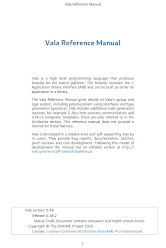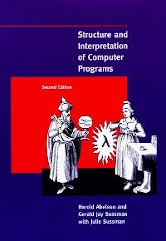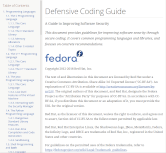Last Updated on February 10, 2024
Vala is an object-oriented programming language with a self-hosting compiler that generates C code and uses the GObject system.
Vala combines the high-level build-time performance of scripting languages with the run-time performance of low-level programming languages.
Vala is syntactically similar to C# and includes notable features such as anonymous functions, signals, properties, generics, assisted memory management, exception handling, type inference, and foreach statements.
Its developers, Jürg Billeter and Raffaele Sandrini, wanted to bring these features to the plain C runtime with little overhead and no special runtime support by targeting the GObject object system. Rather than compiling directly to machine code or assembly language, it compiles to a lower-level intermediate language. It source-to-source compiles to C, which is then compiled with a C compiler for a given platform, such as GCC.
Did you always want to write GTK+ or GNOME programs, but hate C with a passion? Try Vala.
Vala is published under the GNU Lesser General Public License v2.1+.
1. Vala Reference Manual

The Vala Reference Manual gives details on Vala’s syntax and type system, including polymorphism using interfaces and type parameters (generics).
Vala includes additional code generation routines, for example D-Bus inter-process communication and GTK+3 composite templates, these are only referred to in the Attributes section.
The reference manual does not provide a tutorial for these features.
The book is published under the Creative Commons Attribution-ShareAlike 4.0 International license.
2. Structure and Interpretation of Computer Programs by Harold Abelson and Gerald Jay Sussman with Julie Sussman

Structure and Interpretation of Computer Programs is a textbook which teaches the principles of computing programming. It is a classic text in computer science, a definite must read.
Although this book is not Vala specific, it’s essential reading for anyone looking to learn this language. The book offers a big step forward in developing your understanding of functional programming. You’ll want to learn about lambda expressions, true closures, and more.
The book focuses on the main role played by different approaches to dealing with time in computational models.
The material in this book has been the basis of MIT’s entry-level computer science subject since 1980. The authors use the programming language Lisp to educate the reader.
3. Defensive Coding Guide by Red Hat, Inc.
 This guide provides guidelines for improving software security through secure coding. It covers common programming languages and libraries, and focuses on concrete recommendations.
This guide provides guidelines for improving software security through secure coding. It covers common programming languages and libraries, and focuses on concrete recommendations.
There’s a section of this guide that’s dedicated to Vala.
All books in this series:
| Free Programming Books | |
|---|---|
| Ada | ALGOL-like programming language, extended from Pascal and other languages |
| Agda | Dependently typed functional language based on intuitionistic Type Theory |
| Arduino | Inexpensive, flexible, open source microcontroller platform |
| Assembly | As close to writing machine code without writing in pure hexadecimal |
| Awk | Versatile language designed for pattern scanning and processing language |
| Bash | Shell and command language; popular both as a shell and a scripting language |
| BASIC | Beginner’s All-purpose Symbolic Instruction Code |
| C | General-purpose, procedural, portable, high-level language |
| C++ | General-purpose, portable, free-form, multi-paradigm language |
| C# | Combines the power and flexibility of C++ with the simplicity of Visual Basic |
| Clojure | Dialect of the Lisp programming language |
| ClojureScript | Compiler for Clojure that targets JavaScript |
| COBOL | Common Business-Oriented Language |
| CoffeeScript | Transcompiles into JavaScript inspired by Ruby, Python and Haskell |
| Coq | Dependently typed language similar to Agda, Idris, F* and others |
| Crystal | General-purpose, concurrent, multi-paradigm, object-oriented language |
| CSS | CSS (Cascading Style Sheets) specifies a web page’s appearance |
| D | General-purpose systems programming language with a C-like syntax |
| Dart | Client-optimized language for fast apps on multiple platforms |
| Dylan | Multi-paradigm language supporting functional and object-oriented coding |
| ECMAScript | Best known as the language embedded in web browsers |
| Eiffel | Object-oriented language designed by Bertrand Meyer |
| Elixir | Relatively new functional language running on the Erlang virtual machine |
| Erlang | General-purpose, concurrent, declarative, functional language |
| F# | Uses functional, imperative, and object-oriented programming methods |
| Factor | Dynamic stack-based programming language |
| Forth | Imperative stack-based programming language |
| Fortran | The first high-level language, using the first compiler |
| Go | Compiled, statically typed programming language |
| Groovy | Powerful, optionally typed and dynamic language |
| Haskell | Standardized, general-purpose, polymorphically, statically typed language |
| HTML | HyperText Markup Language |
| Icon | Wide variety of features for processing and presenting symbolic data |
| J | Array programming language based primarily on APL |
| Java | General-purpose, concurrent, class-based, object-oriented, high-level language |
| JavaScript | Interpreted, prototype-based, scripting language |
| Julia | High-level, high-performance language for technical computing |
| Kotlin | More modern version of Java |
| LabVIEW | Designed to enable domain experts to build power systems quickly |
| LaTeX | Professional document preparation system and document markup language |
| Lisp | Unique features - excellent to study programming constructs |
| Logo | Dialect of Lisp that features interactivity, modularity, extensibility |
| Lua | Designed as an embeddable scripting language |
| Markdown | Plain text formatting syntax designed to be easy-to-read and easy-to-write |
| Objective-C | Object-oriented language that adds Smalltalk-style messaging to C |
| OCaml | The main implementation of the Caml language |
| Pascal | Imperative and procedural language designed in the late 1960s |
| Perl | High-level, general-purpose, interpreted, scripting, dynamic language |
| PHP | PHP has been at the helm of the web for many years |
| PostScript | Interpreted, stack-based and Turing complete language |
| Prolog | A general purpose, declarative, logic programming language |
| PureScript | Small strongly, statically typed language compiling to JavaScript |
| Python | General-purpose, structured, powerful language |
| QML | Hierarchical declarative language for user interface layout - JSON-like syntax |
| R | De facto standard among statisticians and data analysts |
| Racket | General-purpose, object-oriented, multi-paradigm, functional language |
| Raku | Member of the Perl family of programming languages |
| Ruby | General purpose, scripting, structured, flexible, fully object-oriented language |
| Rust | Ideal for systems, embedded, and other performance critical code |
| Scala | Modern, object-functional, multi-paradigm, Java-based language |
| Scheme | A general-purpose, functional language descended from Lisp and Algol |
| Scratch | Visual programming language designed for 8-16 year-old children |
| SQL | Access and manipulate data held in a relational database management system |
| Standard ML | General-purpose functional language characterized as "Lisp with types" |
| Swift | Powerful and intuitive general-purpose programming language |
| Tcl | Dynamic language based on concepts of Lisp, C, and Unix shells |
| TeX | Markup and programming language - create professional quality typeset text |
| TypeScript | Strict syntactical superset of JavaScript adding optional static typing |
| Vala | Object-oriented language, syntactically similar to C# |
| VHDL | Hardware description language used in electronic design automation |
| VimL | Powerful scripting language of the Vim editor |
| XML | Rules for defining semantic tags describing structure ad meaning |
